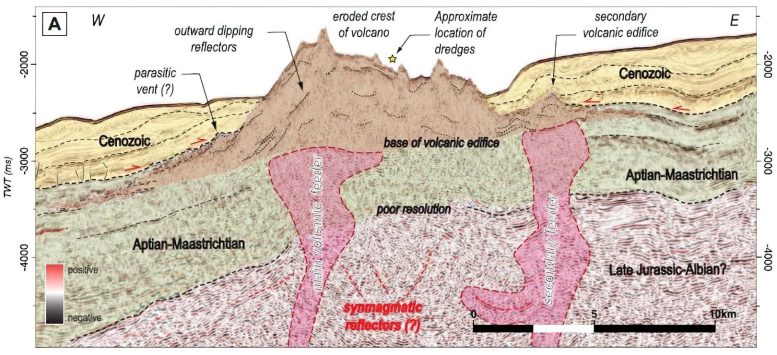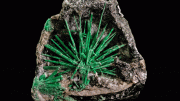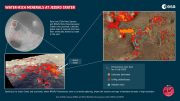A new study suggests that an extinct offshore volcano in Portugal can potentially store 1.2-8.6 gigatons of carbon dioxide, representing 24-125 years of the country’s industrial emissions. The method involves ‘in situ mineral carbonation,’ where CO2 reacts with specific rock elements to create new, safely stored minerals. This efficient and quick method could pave the way for using other offshore volcanoes globally for carbon capture and storage.
A new study published in the scientific journal Geology concludes that an extinct volcano off the shore of Portugal could store as much as 1.2-8.6 gigatons of carbon dioxide, the equivalent of ~24-125 years of the country’s industrial emissions. For context, in 2022 a total of 42.6 megatons (0.0426 gigatons) of carbon dioxide was removed from the atmosphere by international carbon capture and storage efforts, according to the Global CCS Institute. The new study suggests that carbon capture and storage in offshore underwater volcanoes could be a promising new direction for removal and storage of much larger volumes of the greenhouse gas from the atmosphere.
“We know that most countries, including Portugal, are making efforts to decarbonize the economy and our human activities, this is a message that this may be one of the instruments to solve the problem,” says Ricardo Pereira, a geologist at the NOVA School of Science and Technology, and co-author of the study.

Schematic cross-section of the Fontanelas volcano, indicating possible sites for carbon dioxide sequestration. Credit: Pereira and Gamboa, 2023
Storing carbon dioxide in an extinct volcano would rely on a process known as ‘in situ mineral carbonation.’ In this process, carbon dioxide reacts with elements in certain types of rocks to produce new minerals that safely and permanently store the carbon dioxide. Elements like calcium, magnesium, and iron combine with carbon dioxide to form the minerals calcite, dolomite, and magnesite, respectively.
Rocks that contain large amounts of calcium, iron, and magnesium are ideal candidates for this process—such as the volcanic basalts that make up most of the sea floor. Knowing this, the researchers targeted an offshore volcano for a few reasons—the structure of the volcano could provide an ideal architecture for carbon injection and storage, the rocks are the right type for the reactions involved, and the location Is not too close to large populations, but also not too far.
Most carbon capture projects have relied on injection of carbon dioxide into porous sedimentary basins that are sealed to prevent migration of the gas out of reservoirs. In these cases, the carbon will eventually start to form minerals, but only over longer periods of time—decades to centuries.
In 2016, researchers published findings that 95% of carbon dioxide injected into underground basalts in Iceland had mineralized within just two years. The much shorter mineralization time makes the process safer and more effective—once carbon is stored in minerals, issues like potential leaks are no longer a concern.
Davide Gamboa, a geologist at the University of Aveiro and co-author of the study, explains, “What makes mineral carbonation really interesting is the time. The faster it gets into a mineral, the safer it becomes, and once it’s a mineral, it is permanent.”
The researchers studied the storage potential at the ancient Fontanelas volcano, which is partially buried ~100 kilometers offshore from Lisbon, with a peak ~1500 meters below sea-level.
To estimate the potential volume of carbon dioxide that could be stored at this site, the authors used 2D and 3D seismic studies of the undersea volcano that had been produced during offshore oil exploration, as well as data from samples that had been dredged from the area in 2008. The dredged samples contained naturally formed carbonate minerals, indicating that the chemical reactions required to store carbon were already happening, and that intentional efforts to mineralize carbon in these rocks should be successful. The samples also had up to 40% pore space—meaning there are spaces within the rocks where carbon dioxide could be injected and mineralized. The researchers also indicate that low-permeability layers imaged around the flanks of the volcano could help with containing the carbon dioxide before it is mineralized.
While this study demonstrated a large potential carbon storage capacity at the Fontanelas volcano, the authors highlight that many other places around the world may have similar offshore volcanoes that could be candidates for carbon capture and storage.
Reference: “In situ carbon storage potential in a buried volcano” by Ricardo Pereira and Davide Gamboa, 16 May 2023, Geology.
DOI: 10.1130/G50965.1










Great study 🙂
How about giving it to plants, you know, to grow them bigger, and create more oxygen. Naaa, let’s come up with a scheme to get money from the common slaves.
“Elements like calcium, magnesium, and iron combine with carbon dioxide to form the minerals calcite, dolomite, and magnesite, respectively.”
That should be “calcite, magnesite, and siderite, respectively.” Dolomite is a mineral intermediate between calcite and magnesite.
If it is worth mentioning, it is worth getting it right. Some people are learning about science reading here. The last thing that one should be doing is misinforming those readers.
and siderite is ferrous iron carbonate requiring reducing conditions. Most of the Earth’s carbonates are made by organisms that are aerobes…limestones.
https://scitechdaily.com/doubt-cast-on-carbon-capture-by-stanford-study-it-usually-increases-air-pollution/
It is usually the unexamined assumptions that gets one into trouble. In this case, the unexamined assumption is that Carbon Capture can be done efficiently and without contributing to the problem. It appears that is debatable.
CO2 is an essential gas in fact the gas of life try living without it present as less than one percent of the total atmosphere…. All they are doing is trying to make money and control the worlds food supply and people the planet has has massive amounts of co2 in it’s history and the planet became greener not warmer please don’t fall for this scam.
8.6 gigatons sounds like a lot, but just one part per million of CO2 is 7.8 gigatons. Even if captured the atmosphere today contains ~420 ppm. It wouldn’t even miss it. These carbon capture schemes are an expensive scam (if trying to impact climate is the goal).
We are still 1.5 to 2 degress C COLDER than we were in 8000BC to 4000BC. That was coming out of an ice age.
We need those gigatons to get back to warmer, pre-ice age temps.
CC crisis is a lie.